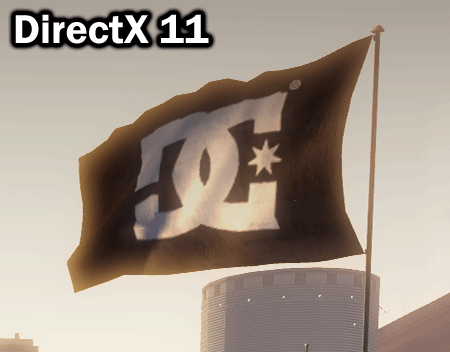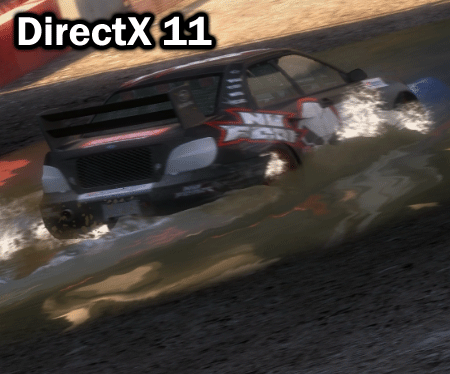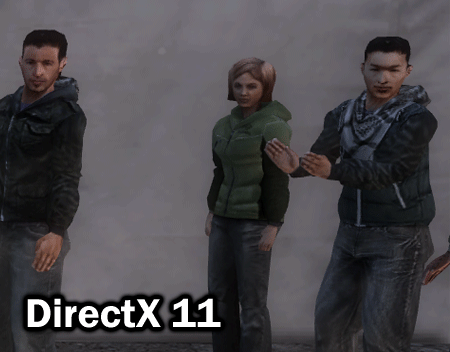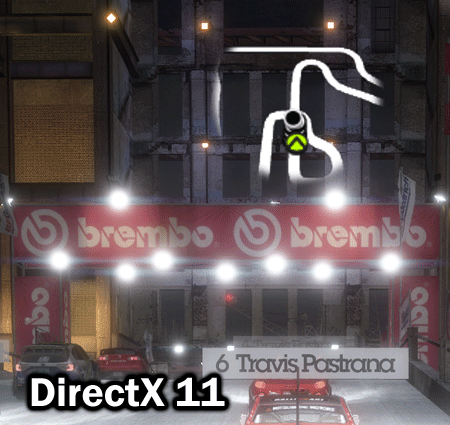DiRT 2: DirectX 11 Game Performance Compared And Analyzed
Image Quality: DirectX 11 Enhancements
Hardware Tesselation: Water, Crowd, and Cloth
In layman's terms, hardware tessellation creates extra detail on simple 3D geometry where none would otherwise exist. Without devoting pages to theory, the best way to describe the effect is with pictures, each worth at least a thousand words:
DiRT 2 will apply hardware tessellation not only to the flags in the game, but also to the crowd and pools of water through which the cars drive.
Note how the water geometry is flat in DirectX 9 mode, while DirectX 11 allows for waves to be created out of tessellated geometry.
As for the crowd, the effect is subtle. Look at the character on the right side of the screen and note the hard edges of the geometry in DirectX 9 compared to the soft edges in DirectX 11. Also pay attention to the detail in the hands and fingers.
While hardware tessellation can be used for dramatic effects, it is extremely hard to notice in DiRT 2 because none of these elements are prominent while racing. For example, you never stop the car during a race to scrutinize a flag, the crowd, or the water as you drive through it. These subtle details speed by so quickly that they are almost impossible to spot while actually playing.
DirectCompute 11 Accelerated HD Ambient Occlusion
Get Tom's Hardware's best news and in-depth reviews, straight to your inbox.
Ambient occlusion (AO) is a feature used to increase the realism of a game's lighting model. AO algorithms simulate the phenomenon where light has a hard time illuminating cracks and crowded spaces. A picture is also the best way to explain it:
While this enhances the lighting model very well, once again we have a feature that is difficult to spot in-game when everything is going by the camera quickly.
Full-Screen Resolution Post Processing
In DirectX 9 mode, some of DiRT 2's post-processing filters are run at one-quarter resolution to maintain high performance. However, in DirectX 11 mode, this post-processing is done at full resolution. The resulting quality increase is difficult to notice during daylight races, but is easy to notice in the night shots where a Gaussian glow filter is applied to lights.
Full Floating Point High Dynamic Range Lighting
Difficult to display in an image, DirectX 11 allows for a full floating point R16G16B16A16 texture when calculating high dynamic range lighting as opposed to the R8G8B8A8 fixed-point format used in DirectX 9 mode. This results in a theoretical bump in overall rendering quality, although the effect is so subtle that, again, it is difficult to demonstrate.
Current page: Image Quality: DirectX 11 Enhancements
Prev Page Image Quality: GeForce Versus Radeon Next Page Image Quality: DirectX 11 Enhancements, Cont'd.Don Woligroski was a former senior hardware editor for Tom's Hardware. He has covered a wide range of PC hardware topics, including CPUs, GPUs, system building, and emerging technologies.
-
eklipz330 im sure when true dx11 games come out, the difference won't be so subtle anymore.. game looks great either wayReply -
rbarone69 I have to say, Dirt 2 is a great game if you like the rally/baja type car racing. Regardless of the graphics differences the game play is simply fun. It's not "real to life" like Forza, but it is a blast playing if you like sliding around corners on track that's not necessarily pavement.Reply
-
Onyx2291 Looks good, gotta be honest though I probably wouldn't see much of a difference if I just played the game without taking a good look at stuff. Maybe except for the water.Reply -
Sihastru One down, one or two to go ;)Reply
Until DX11 does not become mainstream (eg. 90% of the users will have DX11 capable cards) you can't expect to see differences between DX11 and DX9/10 modes. Why? Because they won't make games where one player sees something and the other does not, to the point that will actually mean something and affect the gameplay.
So anyone that bought the cards for DX11 will not get anything extra from the DX11 code path. No developer that wants to sell a game would code it so that you'd need a new card to play the game. They would not shoot themselves in the foot.
DX11 is now in the position PhysX was, and I'm not necessarily speaking about the CUDA PhysX version, but the original PhysX by Ageia, when you needed a PCI card for it. It had and still has great potential, but you can't use it to it's full extent until people embrace it and make it mainstream. Until then, all the developers can do is to use certain features here and there, so that it gives you a glimpse of what it could be, but not so much that it makes a difference and modifies the experience too much. They just don't want to give up customers, it's not just that they don't want to use the technology.
And when DX11 finally becomes mainstream, in 6-12-18 months, the current DX11 cards will be nearly obsolete performance wise... truly tragic. But that's the way the cookie crumbles...
It's a bit of a troll-ish post (it may seem that way, if you have an ATI DX11 card), and I will get "-1" all round but it's the truth if you think about it from a safe distance. Too bad you... yes... you... the one clicking the "Useless message" icon, won't even get to this last paragraph. -
coolronz DirectCompute 11..? Doesnt my GTX260 support that? So will I beable to enable that, but not hardware tesselation etc..?Reply -
cryogenic Dirt 2 uses a DX 9 engine, so I guess this is not such a big surprise, although I've expected more from DX 11 integration, actually **allot** more, considering that the game was marketed as the first DX 11 title out there.Reply
It's rather disappointing to see such small visual differences between DX9 and DX11 versions, even though I've never expected rather major ones from this title.
My hope is that DX 11 will become mainstream very fast, and developers will focus on getting the most out of it soon. Congrats to all that got DX 11 cards this christmas(me included). The DX9 performace is great and the fact that DX11 gains market share is even greater.
-
cryogenic Dirt 2 uses a DX 9 engine, so I guess this is not such a big surprise, although I've expected more from DX 11 integration, actually **allot** more, considering that the game was marketed as the first DX 11 title out there.Reply
It's rather disappointing to see such small visual differences between DX9 and DX11 versions, even though I've never expected rather major ones from this title.
My hope is that DX 11 will become mainstream very fast, and developers will focus on getting the most out of it soon. Congrats to all that got DX 11 cards this christmas(me included). The DX9 performace is great and the fact that DX11 gains market share is even greater. -
frederico "And when DX11 finally becomes mainstream, in 6-12-18 months, the current DX11 cards will be nearly obsolete performance wise... truly tragic. But that's the way the cookie crumbles..."Reply
I think, I'm not sure though, but I think he is somehow trying to say that in the 'future' your DX11 graphics card may need to be upgraded to a more powerful DX11 graphics card. Something that has been happening with every graphics card for the last 20 years. I am not sure I can deal with all the tragedy. -
h83 I could be wrong, but i think that the only game that will probably show the full potential of DX11 it´s going to be Crysis 2, so prepare your wallets for the PC upgrade...Reply -
LATTEH dirt 2 looks awesome in DX 9 or DX11 anyone who buys it will be able to enjoy its beautyReply




